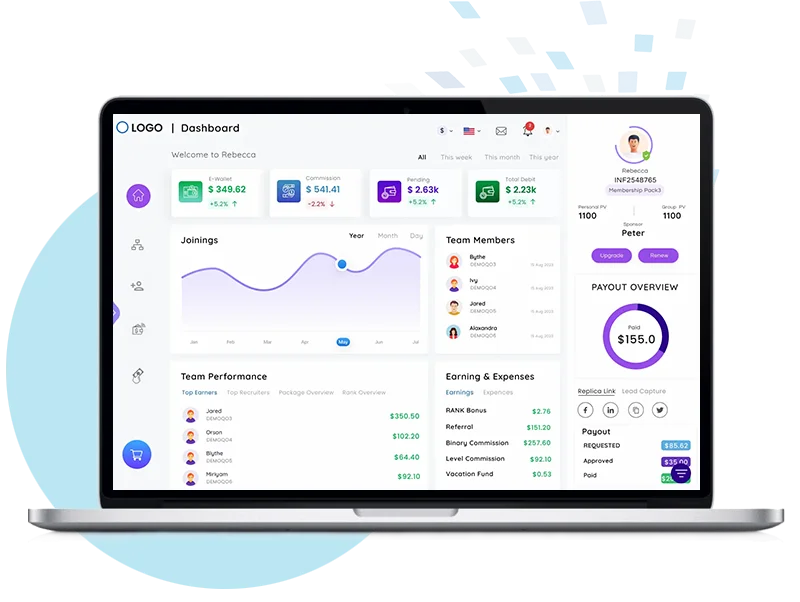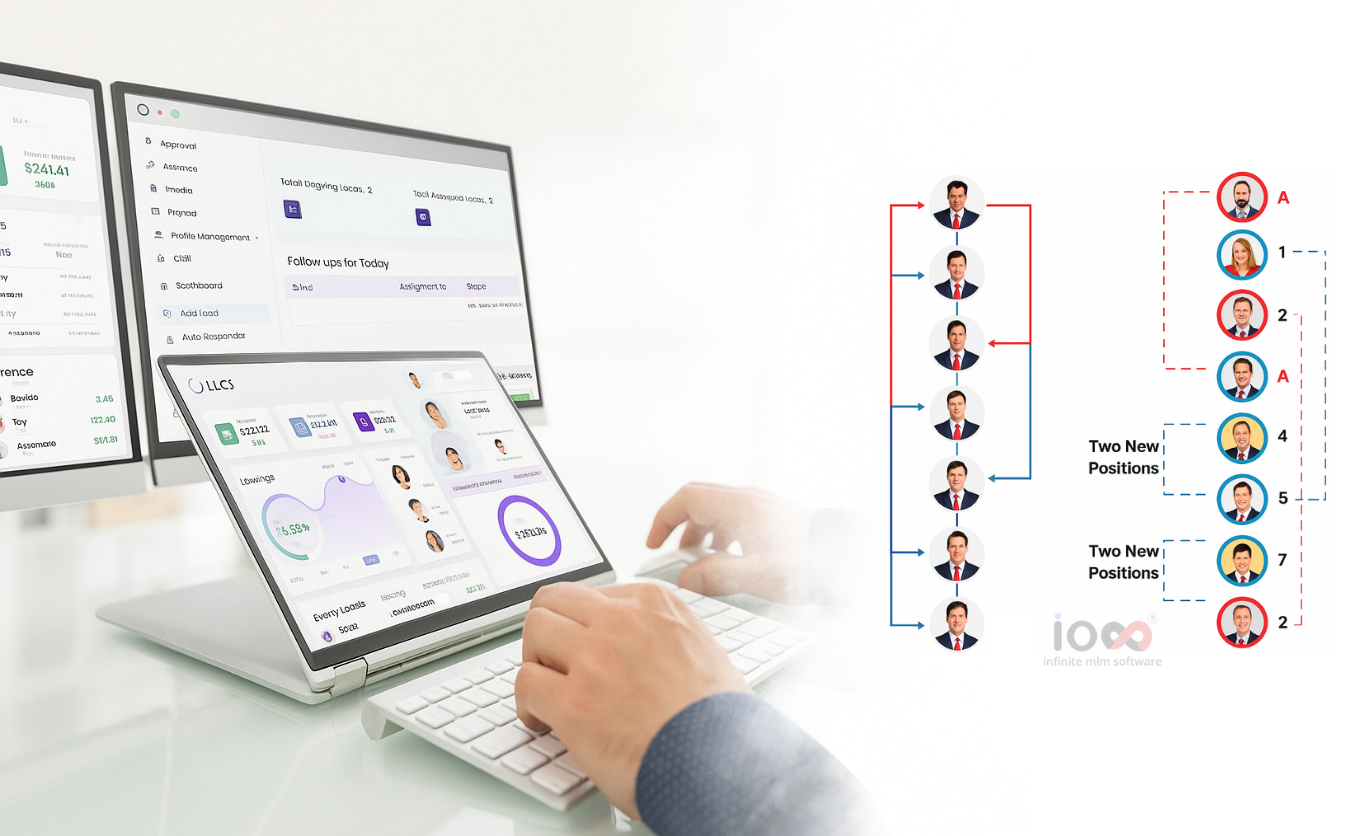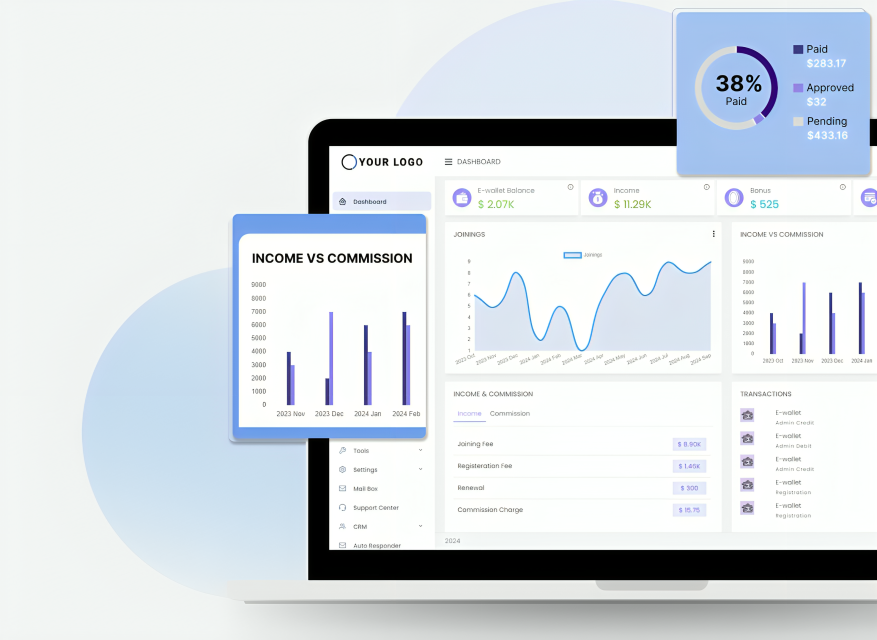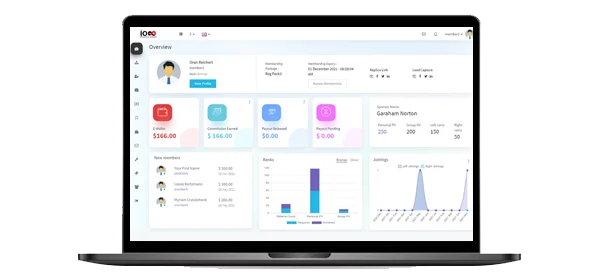In a market where most MLM plans involve complex leg-balancing, sponsor coordination, and strategic placements, the Single Leg MLM Plan (or Monoline Plan) offers a simpler alternative; one straight line, no branching, no confusion.
What powers this model is intelligent MLM software that automates user placement, spillover earnings, commission distribution, and more making it ideal for fast-growing teams and startups.
If you’re looking for a scalable, low-friction plan that rewards both active and passive members, this guide will help you explore how the single leg system works, its benefits, risks, and where it fits best.
What Is Single Leg MLM Software?
Single Leg MLM Software is a specialized network marketing tool designed to manage and automate the operations of a Single Leg (Monoline) MLM Plan. In this type of MLM structure, all members are placed in a single straight line, one below the other, regardless of who referred them. The software ensures that each new member is automatically positioned at the next available spot in this vertical chain.
It handles everything from user registration, placement, commission calculation, to bonus distribution, making it easy for MLM companies to scale while offering a simplified compensation model.
Why Use Single Leg MLM Software?
It simplifies network building, motivates passive users through spillover, and reduces the complexity often associated with binary or matrix plans. Ideal for startups and fast-scaling MLM ventures, it offers a plug-and-play system to launch and manage single leg plans efficiently.
Let me know if you’d like this turned into a landing page, comparison sheet, or product brochure content.
MLM Bonuses & Single Leg Software Functionality
In a Single Leg MLM Plan, earnings are not limited to commissions based on product sales or purchases alone. To enhance distributor motivation and accelerate network growth, companies often incorporate a variety of commission and bonus structures. These bonuses reward users for activities like direct referrals, team performance, and account reactivations.
Below are the most common bonus types configured within Single Leg MLM software:
1. Referral or Sponsor Bonus
This is the most fundamental bonus offered in nearly every MLM structure. In a single leg plan, when a user refers to someone using their unique referral link or sponsor ID through referral programs, they earn a Referral Bonus.
How It Works:
- Paid immediately after a successful registration or package purchase.
- The bonus amount can be a fixed amount or a percentage of the new member’s package value.
- Encourages active recruitment and front-line engagement.
Example:
If you refer a new member who purchases a $100 package and your referral bonus is 10%, you earn $10 instantly.
2. Matching Bonus
The Matching Bonus rewards sponsors for helping their team members earn. Whenever a downline member receives an income (from commissions or bonuses), their sponsor earns a percentage of that income.
How It Works:
- Typically applies across multiple levels depending on the compensation plan.
- Encourages mentorship and support because your income is tied to how well your team performs.
- Often capped by rank- progression, activity, or number of active referrals.
Example:
If your direct downline earns $200 in a week, and your matching bonus is set at 20%, you receive $40 as a matching bonus.
3. Rejoin Bonus
The Rejoin Bonus (also known as Cycle or Reactivation Bonus) is paid when a distributor reactivates an old account, repurchases a plan, or completes a cycle in plans where members are allowed to re-enter after completing one income cycle.
How It Works:
- Encourages continued participation from older or dormant accounts.
- Can be used in loop plans, cycling plans, or when users hit earning caps and re-enter.
- The bonus may be awarded to the original sponsor or placed as part of a re-entry spillover strategy.
Example:
A user completes their initial earning cycle and re-enters the system by purchasing a new package. Their original sponsor earns a rejoin bonus, which could be a flat reward or a percentage of the repurchase.
Bonus Types Overview
| Bonus Type | Trigger | Benefit to Distributor |
|---|---|---|
| Referral Bonus | Directly referring a new member | Immediate income for every new recruit |
| Matching Bonus | Downline members earning commissions | Percentage of team earnings across levels |
| Rejoin Bonus | User reactivating or rejoining the system | Incentivizes long-term activity and recycling |
How Commissions Flow in a Single Leg Plan?
In a single leg MLM plan, the commission structure is designed to reward uplines for the activity of their downlines. The software automatically calculates and distributes commissions based on predefined payout levels.
Here’s a simplified example of how earnings flow:
- User A joins first and refers to User B.
- User B then refers to User C, and so on.
- However, even if User D is referred by User A, the system will still place D under the last person in the line (User C).
- User A, despite D being deep in the downline, may still earn commissions from D’s activities if the plan allows payout across multiple levels.
This ensures that active and early users benefit, but also that new recruits are encouraged by seeing commissions coming in from below even when they haven’t personally recruited anyone.
Understanding Spillover and Passive Earnings
Spillover is a core attraction of the single leg structure. It refers to the process where new members added by uplines are automatically placed beneath existing users. This means that:
- You don’t need to recruit to have a growing team.
- If someone above you is actively recruiting, you still benefit by having those new users placed in your downline.
- You earn commissions based on their purchases or activities as per the payout rules.
In short, inactive or less active members can still earn, which keeps them motivated and engaged in the system. This passive earning potential reduces dropout rates and increases the overall stability of the MLM network.
How Downline Progression and Commission Works
Here’s a basic illustration of how users are added and how commissions may flow:
| Level | Member | Placement Source | Commission Flow To |
|---|---|---|---|
| 1 | A (Top User) | First Registered | — |
| 2 | B | Referred by A | A |
| 3 | C | Referred by B | B → A |
| 4 | D | Referred by Upline | C → B → A |
| 5 | E | Referred by C | D → C → B → A |
What Is a Single Leg MLM Plan?
A Single Leg MLM Plan, also known as a Monoline Plan, is one of the most straightforward and easy-to-understand structures in the MLM industry. In this model, every new distributor is placed in a single straight line, one after the other, regardless of who referred them. This creates a unified downline where all members are stacked beneath their predecessors in a vertical hierarchy.
Unlike Binary MLM Plans, which require building two legs, or Unilevel Plans, which allow multiple frontline members, the single leg model simplifies team building and eliminates structural complexities. All users join a common global downline, meaning there’s no competition for placement, everyone progresses under the same tree.
This structure is especially suited for fast-scaling network marketing companies that value rapid onboarding, team collaboration, and equal opportunity for earnings.
Why Choose the Single Leg Model?
- Simple Architecture: Easy to explain, set up, and scale.
- Faster Team Growth: Since all recruits join one line, it encourages collective growth.
- Greater Earning Potential for All: Even passive members can earn from spillovers.
- Minimal Maintenance: No need to balance legs or manually assign members.
- High Motivation: Seeing direct additions to one’s downline, even without effort, increases engagement.
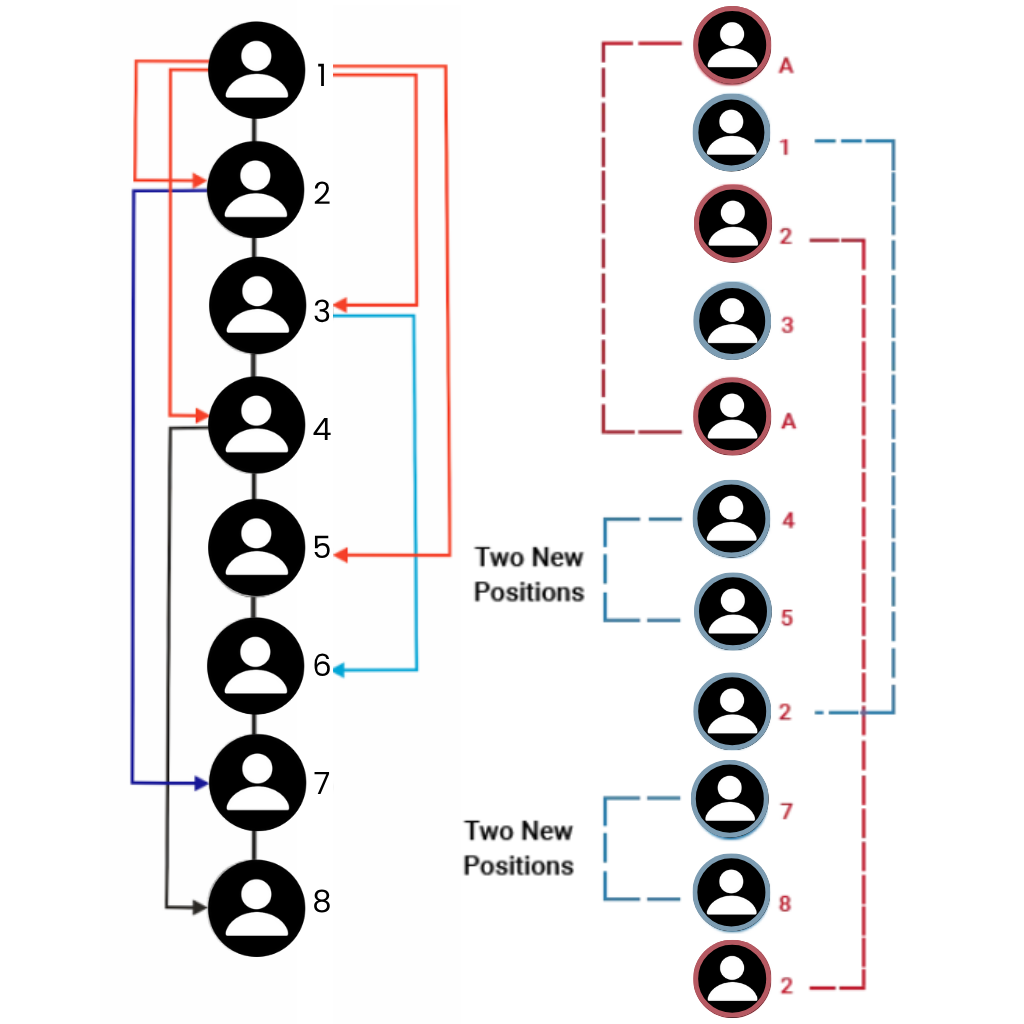
E.g.; To understand the structure, picture a vertical tree or chain:
Each new user joins the next available spot in the line, and the software automatically places them there. No manual intervention is required. This sequential format eliminates the common confusion seen in other plans where the distributor has to decide where to place a recruit.
Key Features of Single Leg MLM Software
To ensure the seamless operation of a Single Leg MLM Plan, the software powering it must be robust, automated, and optimized for large-scale user engagement. Below are the essential features that make such software capable of supporting exponential growth while maintaining administrative control and user satisfaction.
1. User Registration System
A smooth and intuitive registration system is crucial for onboarding new distributors quickly and effectively. The software allows users to register through:
- Referral links shared by existing distributors
- Sponsor IDs manually entered during sign-up
- Admin-assigned placement for manual control in certain cases
This ensures that users are properly linked to their referrer, maintaining the integrity of the commission structure. The system can also support email and phone verification, password setup, and user profiling during sign-up, offering a professional and secure onboarding experience.
2. Auto Downline Joining
One of the hallmarks of a single leg plan is automatic placement. As new members join, the system places them in the next available position in the downline tree without any manual effort from users or administrators. This feature ensures:
- Zero placement errors
- Equal opportunity for spillover-based growth
- Fast and continuous downline formation
This automation removes the complexity of tree management, making the business model especially appealing to beginners.
3. E-Wallet Integration
Every distributor is provided with a personal e-wallet within the software. This wallet acts as a secure repository for:
- Earned commissions
- Promotional bonuses
- Cashback or rewards
- Transferable funds
Users can:
- Withdraw balances based on company policies
- Reinvest or purchase products
- Transfer funds to other users (if permitted)
The wallet system supports transaction history, withdrawal requests, and integration with payment gateways such as PayPal, Stripe, Razorpay, or cryptocurrency wallets ensuring convenience and financial transparency.
4. Automated Commission Calculations
One of the most powerful aspects of MLM software is its ability to calculate commissions automatically. In a single leg plan, the software:
- Tracks downline activities and purchases
- Applies commission rules to determine who qualifies for earnings
- Calculates level-wise payouts instantly
- Processes bonuses, rewards, or matching commissions (if enabled)
This automation removes the need for manual data handling and ensures real-time accuracy. Whether it’s daily product purchases or new registrations, the software instantly updates the earning summary for each eligible user.
5. Flexible Payout Scheduling
To maintain distributor satisfaction and cash flow integrity, the software allows custom automated payout schedules, such as:
- Daily payouts for highly active systems
- Weekly payouts for balanced cash flow
- Monthly payouts for batch processing
Admins can define:
- Minimum payout thresholds
- Payment processing days
- Verification steps (e.g., KYC before first payout)
This flexibility helps companies maintain control over liquidity while offering predictable income for their members.
6. Admin Dashboard
The software comes with an advanced and secure admin dashboard that enables real-time monitoring of all key aspects of the MLM operation. From a single interface, administrators can view:
- User growth metrics: Total signups, active vs. inactive users
- Downline trees: Visual or tabular representation of user hierarchies
- Commission and payout reports: Detailed logs and summaries of earnings
- Sales performance tracking: Product/package-wise revenue breakdowns
- Bonus eligibility and redemption status
The dashboard may also include alerts, notifications, report export options, and role-based access controls empowering management teams to make informed decisions and take timely action.
7. Referral Link Tracking
Each distributor receives a unique referral link which they can share through social media, email, messaging apps, or embedded on websites. The system:
- Tracks each click and signup from the referral link
- Automatically connects the new user to the correct sponsor
- Logs conversion data for performance analytics
This feature provides users with a clear view of their recruitment efforts, including:
- How many people clicked their link
- How many converted into active users
- Which platforms are driving the most traffic
For marketers and influencers, this is an essential tool for maximizing outreach and optimizing their promotional strategies.
Understanding the Single Leg Compensation Structure
The Single Leg MLM plan operates on a first-come-first-serve basis, where every new member is placed in a single line beneath the previous one. You earn commissions not just from your own sales but also from the sales of everyone below you; whether they are your direct recruits or spillovers.
Typically, companies may require you to sponsor a certain number of individuals (like 2 or 3) before you start earning commissions. Once eligible, you might receive a higher percentage (e.g., 10%) from your direct recruits and a lower percentage (e.g., 5%) from the rest of the downline. This structure encourages both individual effort and collective growth.
While simple and inclusive, the payout rules and qualifying conditions can vary depending on the company’s specific plan.
Pros of a Single Leg MLM Plan
The single leg plan offers multiple advantages that make it particularly attractive for new companies and first-time distributors:
- Simplified Structure
There’s no complexity in managing multiple legs or trees. Everyone joins in sequence, which reduces confusion and technical errors in placement. - Spillover Encourages Passive Participation
Even users who do not recruit benefit from the activity of others above them. Spillover motivates passive members to stay connected, as they begin seeing earnings over time. - Quick Team Growth
Since all recruits are placed in one line, the downline grows rapidly. This momentum creates a sense of excitement and urgency to join early and maximize position-based benefits. - High Retention
Members tend to stay longer in the system because even inactive users can earn. It reduces dropout rates and stabilizes the network. - Ideal for Beginners
The plan is easy to understand and explain. It doesn’t demand recruiting skills or strategic tree planning, making it beginner-friendly.
Cons of a Single Leg MLM Plan
While the single leg plan has strong appeal, it also comes with certain limitations and challenges that businesses and distributors should consider:
- Limited Control Over Placement
Distributors have no say in where their recruits are placed. All new members are stacked at the end of the line, which can demotivate those who wish to build and manage their own teams. - Passive Culture Risk
Since members can earn without effort due to spillover, some users may never become active recruiters, slowing down network growth once the top leaders reduce their efforts.
Conclusion
If you’re aiming for fast growth, easy onboarding, and a model that even rewards passive users, Single Leg MLM Software offers a powerful solution. It automates placement, commissions, and spillover tracking, so you can focus on scaling and engagement.
Just remember: while spillover drives retention, balance is key. Smart limits and performance-based incentives ensure long-term sustainability.
In short: It’s more than software; it’s a scalable growth strategy. Simple, Efficient, Built for momentum, perfect for startups and established MLMs ready to simplify success.
FAQs
A Single Leg MLM Plan places every new member in a single straight line, one after another regardless of who referred them. There’s only one downline path, making it simple and easy to manage. In contrast, a Binary MLM Plan splits downlines into two legs (left and right). Distributors must maintain balance between these legs to qualify for commissions. Binary plans offer more complexity and strategic placement, while single leg plans focus on equal opportunity and spillover-based growth.
Yes, Single Leg MLM Software is legal, provided it supports a compliant MLM model. This means the business must offer genuine products or services, clear income disclosures, and must not rely solely on recruitment-based earnings. Adhering to national laws and MLM regulations (like the FTC in the U.S. or Consumer Protection guidelines in India) is essential for legal operation.
Spillover income refers to the earnings a user gains from members added by their uplines, not by themselves. Since every new user is placed in a straight line, even passive or inactive members can receive active downlines through spillover, enabling them to earn commissions from purchases or activities of users placed beneath them in the tree. This motivates users to stay active in the system even if they aren’t recruiting.
The average cost of Single Leg MLM Software ranges from $500 to $5,000 or more, depending on factors like:
- Number of users supported
- Custom features (e.g., bonus logic, payout automation)
- Branding and design
- Integration with payment gateways or e-wallets
- Support and maintenance
Some vendors also offer monthly subscription models for added flexibility.
Yes, most providers offer highly customizable MLM software. You can define:
- Your unique commission structure
- Bonus types and payout logic
- Rank-based income conditions
- KYC or withdrawal rules
- Branding (logos, theme, language)
Custom development ensures the system reflects your business model accurately and scales as your network grows.
Absolutely. Single Leg MLM Software is a perfect fit for startups and new MLM companies. The structure is easy to understand, reduces management overhead, and promotes fast downline growth through spillover. It’s also cost-effective and easier to launch compared to complex plans like matrix or hybrid models.
Yes. Most modern MLM software platforms offer mobile-responsive dashboards and, in some cases, dedicated mobile apps. These provide distributors and admins with:
- Real-time tracking of team growth
- Earnings summaries
- Referral link sharing
- Wallet balances
- Commission reports
This makes it easy to manage your business on the go.

